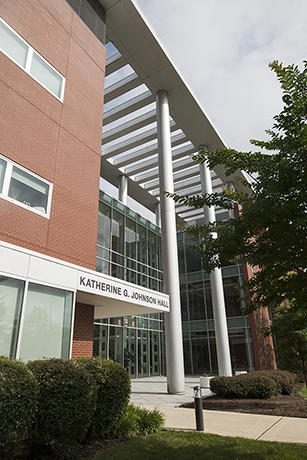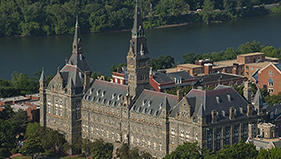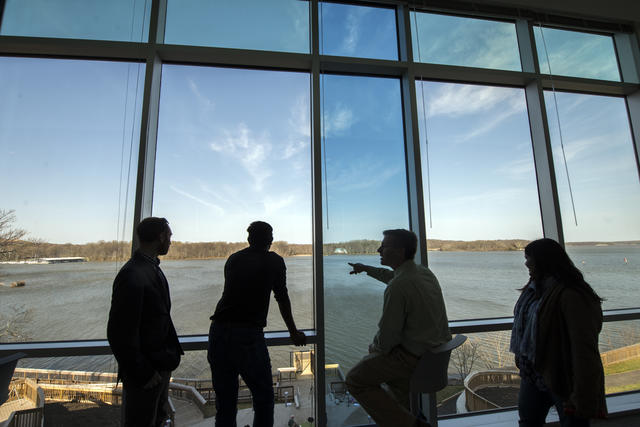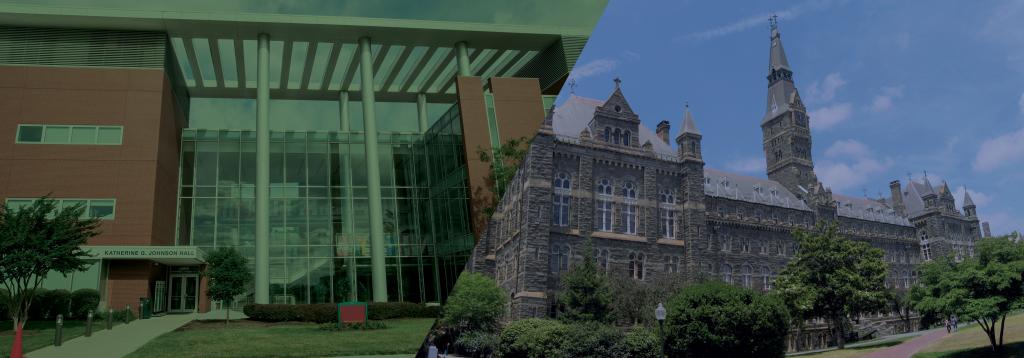Facilities
Main navigation
Section Navigation: Biomedical Sciences Program (GeorgeSquared)
Hands-on learning is more than just a catch phrase for Mason student scientists.
The college offers many innovative learning environments that immerse students in their field of study, from biohazard research labs to crime scene houses.
Mason's Campuses

Science and Technology Campus
The Science and Technology Campus, formerly known as the Prince William Campus, was established in Manassas, Virginia, in 1997. This campus provides convenient university access for citizens of Prince William, Fauquier, and western Fairfax counties; the cities of Manassas and Manassas Park, and adjoining areas to the west and south. The campus is often referred to as SciTech. Our program's classes are held in the Katherine G. Johnson Hall.
Fairfax Campus
The Fairfax Campus location, Mason's original campus, is the principal center for undergraduate studies, with residence halls that house more than 6,000 of our 37,000-plus students. The campus, on 677 wooded acres within 25 minutes of downtown Washington, D.C., offers academic programs in nine colleges and schools:
Arlington Campus
George Mason University’s Arlington Campus is located in the Virginia Square neighborhood of Arlington County. The Arlington Campus hosts the Antonin Scalia Law School, the Schar School of Policy and Government, the School for Conflict Analysis and Resolution, programs in Arts Management and the School of Business, and continuing professional education through Mason’s Executive and Professional Education. Most of the programs offered are at the graduate and professional levels.

Georgetown University School of Medicine
GeorgeSquared students have a unique opportunity to take their anatomy laboratory classwork during the spring semester on the Georgetown University campus.
Science Facilities
Mason’s Biomedical Research Laboratory (BRL)
The BRL, classified as Biosafety Level-3, allows scientists to research infectious diseases as well as both emerging and potential bio-threat agents. The BRL supports research programs of the Center for Infectious Disease Research (CIDR), and provides students the opportunity to perform groundbreaking research on diseases such as the influenza virus, Rift Valley Fever, Zika, HIV, Bacillus anthracis, and more.
Potomac Science Center
The Potomac Science Center serves as a focal point for connecting science at Mason with the local community. Home to the College of Science’s Potomac Environmental Research and Education Center, the Potomac Science Center is a place for environmental education, for scientific research, and for community outreach and connection. The facility includes teaching labs and smart classrooms, as well as eight research lab suites including aquatic ecology and wet chemistry labs and geospatial computer labs. The center also features a hands-on discovery lab for K-12 students, collaborative space, an exhibit hall, and special event space for hosting a variety of mission-related activities.
The Smithsonian-Mason School of Conservation (SMSC)
The SMSC occupies part of the Smithsonian Conservation Biology Institute (SCBI) in Front Royal, Virginia. Nestled alongside the Shenandoah National Park, the entire facility covers 3,200 acres of forest, grassland, and pastures. An active research facility, SCBI houses a range of endangered mammals, birds, and amphibians, which creates a compelling and engaging learning environment for program participants.
Mason’s Crime Scene House
The Crime Science House offers real-life experience for forensic science students to immerse themselves in evidence collection from a variety of authentic mock crime scenes. These graduate students practice processing evidence in the Crime Scene House.
The Greenhouse classrooms
Located on the roof of Exploratory Hall, the greenhouse classrooms provide students with the opportunity to work with a wide variety of plants, from species indigenous to Virginia, to rare plants from Madagascar. Our greenhouse, under the direction of the Biology Department, uses new technology such as a fully automated climate control system, a drip irrigation system, and automated shades and vents to simulate the various growing environments. The Biology Department also maintains the Ted R. Bradley Herbarlum, a collection of dried, pressed plant specimens used for the teaching global research.
Mason’s Observatory
The George Mason Observatory, supported by the Department of Physics and Astronomy, provides opportunities for students to conduct research while working directly with observatory equipment that includes a 32″ Ritchey-Chretien Telescope, 12″ Cassegrain (Mancini), 6″ Solar Telescope, 16″ Dobsonian (Strickland), 2 Meade 12″ SCTs and two telescopes from Mason’s original observatory. The observatory also offers tours and events for the public.
The Ted R. Bradley Herbarium
The Ted R. Bradley Herbarium is an internationally-recognized scientific collection of dried, pressed plant specimens that are maintained for research and teaching. Its specimens are prepared with archival-quality materials, are intended to last for centuries, and are loaned to researchers nationwide and around the world. The Herbarium aims to engage the next generation of botanists and champions the careful stewardship of Virginia’s plant diversity through hands-on education, collections-based research, and public outreach.
Pictured below: The Potomac Science Center is a 50,000-square-foot research facility that houses laboratories for teaching and research, lecture rooms, event space and outdoor trails.

